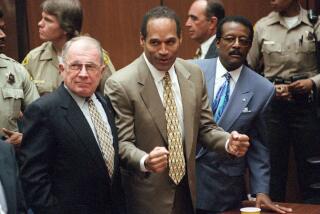Martin L. Perl dies at 87; Nobel winner discovered tau lepton
Long before he would be awarded a Nobel Prize, Martin L. Perl liked to do his own plumbing repairs.
He usually had spare time, and he clearly knew the physics, his oldest son, Jed, recalled. And Martin Perl was, first and foremost, a hands-on experimenter. His persistent re-testing of theories to dispel the doubts of his colleagues eventually proved there was a new subatomic particle that existed for trillionths of a second and was 3,500 times as massive as an electron.
The discovery in 1975 of what now is known as the tau lepton helped fill a gap in the standard model of particle physics and won Perl a Nobel Prize in physics in 1995.
Perl, 87, died of a heart attack Tuesday at Stanford Hospital, according to family members.
“Martin was one of those people who had his own ideas about what’s important in physics, and he pursued those and pursued them hard, and he was right,” said fellow Nobel laureate Burton Richter, who oversaw Perl’s early work at the Stanford Linear Accelerator Center, now the SLAC National Accelerator Laboratory.
Born in 1927 in New York City to Jewish immigrants from Eastern Europe, Perl was encouraged to channel his scientific interests to the more practical career of engineering. He graduated from high school at 16 and enrolled at Polytechnic Institute in Brooklyn. After serving in the merchant marine and the Army during World War II, he received his bachelor’s degree in chemical engineering in 1948 and headed to Schenectady, N.Y., to work for General Electric Co.
Needing a crash course on the electron vacuum tubes that then powered electronics, Perl took classes at Union College, where a professor reportedly advised him that the answer to how electrons behave was not to be found in chemistry, but physics.
“He was bored” at G.E., said Jed Perl. “He actually did a little bit of sculpture at that point, in his early 20s.” Perl’s then-wife, Teri, convinced him to pursue physics at Columbia University, even though he had only a basic course in Newtonian mechanics on his resume.
Perl’s interest in atomic and subatomic particles came as the technology to smash particles into their components was booming in the Cold War atomic age. After getting his doctorate from Columbia and joining the University of Michigan faculty, Perl conducted research at the Brookhaven Cosmotron, then the most powerful accelerator, and at the Berkeley Bevatron.
But by 1962, engineers were building “Project M,” a 2-mile-long linear accelerator in the hills west of Stanford University that would accelerate electrons nearly to the speed of light. Perl accepted a position at the newly christened SLAC in 1963.
It was at that rapidly expanding facility that physicists, Richter among them, proved that smaller particles called quarks underlie protons. Matter was thought to consist of two generations of quarks and leptons (the latter of which includes the electron) accompanied by neutrinos.
Perl suspected there was a third generation, or family, including a lepton far more massive than either the electron or its brother particle, the muon. Many theoreticians were skeptical and remained so even after Perl’s data suggested he had detected it.
Perl confirmed the presence of the new particle in a series of experiments from 1974 to 1977. Much of that time was spent explaining his data to skeptical audiences, then returning to the lab to answer their doubts. He christened the new particle the tau lepton, from the first letter of the Greek word for three.
“It was the first discovery of this third generation that took us 30 years to fill out” with the confirmation of additional quarks, said David MacFarlane, associate lab director for particle physics and astrophysics at SLAC. “It opened up this whole new avenue.”
In an essay marking the 30th anniversary of his discovery, Perl chided his particle physicist colleagues for being slow to acknowledge the existence of dark matter, already a mainstay of astrophysics.
He pushed MacFarlane to let him set up his own experiments related to dark energy in one of several encounters that made a lasting impression on the relatively new administrator. “Here’s someone beyond 80 years, very sharp intellectually, demonstrating an inventiveness that has been the hallmark throughout his career,” MacFarlane said. “We set up a lab for him.”
He lambasted the string theory of particle physics, arguing that it relied too much on theoretical, rather than physical, proof. “We have better things than string theory to work on with our time and limited money,” he wrote.
Perl also was deeply engaged in social issues, pushing the American Physical Society to take a stand against the Vietnam War, an unsuccessful battle that led to the founding of the left-leaning Scientists and Engineers for Social and Political Action in 1969.
At home, Perl was “intense,” his son said, but he cultivated a playful and imaginative side, collecting children’s construction toys: Erector sets, Lincoln Logs and building blocks dating to the 19th century.
“He saw that kind of play as a preparation for scientific exploration,” Jed Perl said. In recent years, he brought that message to students in Asian countries, where science teaching can be rigidly orthodox. “He told them to let their minds wander and use their imagination,” Perl said.
In addition to Jed, of New York City, Perl is survived by his sons Joseph of Oakland and Matthew of San Diego; a daughter, Anne Bernard of Palo Alto; eight grandchildren and one great-grandchild.
geoffrey.mohan@latimes.com
Twitter: @LATsciguy
More to Read
Start your day right
Sign up for Essential California for the L.A. Times biggest news, features and recommendations in your inbox six days a week.
You may occasionally receive promotional content from the Los Angeles Times.





